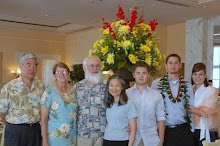http://www.lovethedot.net/2010/02/parallel-programming-in-net-40-and.html
http://fsharpnews.blogspot.com/2010/12/numerical-methods-matrix-inversion.html
Musings
icm 2006 - Demoscene - Mathematics in Movement by Iñigo Quílez
http://www.iquilezles.org/www/material/icm2006/icm2006.htm
… Our demoscene speeches in the ICM were of course a bit technical, but for the Conde Duque we made them quite more generic, showing more "noise and colors" than slides of course. People were impressed, they made many questions and we got a lot of positive feedback, especially in the form of "You HAVE TO show all this to the general public, in the media, go to schools and university, this is fantastic....". Well, that was like a dream for me. In the ICM they were more impressed by the technological side instead, they found impressive that "all that in 64 kilobytes?!" and "that is realtime???", but still got the main idea I wanted to transmit them: "this guys do really enjoy maths and have developed a intuitive and creative way of using it!" …
http://www.mattssoftwareblog.com/?tag=f
Matt: I wrote this little applet to see what the combination of MEF and the F# CodeDom would look like, and for the record it looks really really good.
This combination opens a whole lot of doors. By using the F# CodeDom the plugin source code can brought in from anywhere;
http://graphics.stanford.edu/~yoel/notes/sugerman-thesis.pdf
“GRAMPS is a General Runtime/Architecture for Many-core Parallel Systems. It defines a programming model for expressing pipeline and computation-graph style parallel applications. It exposes a small, high-level set of primitives designed to be simple to use, to exhibit properties necessary for high-throughput processing, and
to permit efficient implementations. We intend for GRAMPS implementations to involve various combinations of software and underlying hardware support, similar for example, to how OpenGL permits flexibility in an implementation’s division of driver and GPU hardware responsibilities. However, unlike OpenGL, we envision
GRAMPS as being without ties to a specific application domain. Rather, it provides a substrate upon which domain-specific models can be built. …” Jeremy Sugerman
,August 2010, SU Dissertation
http://www.mattssoftwareblog.com/?tag=codedom
I wrote this little applet to see what the combination of MEF and the F# CodeDom would look like, and for the record it looks really really good.
This combination opens a whole lot of doors … Matt’s Software Blog, March 21 2010
This is one of the few F# MEF items to show up while searching, but I hope there will be may more – soon.
Manycore-oblivious -- the new cache-oblivious
Trumping the Multicore Memory Hierarchy with Hi-Spade
... is an open membership organization that includes leading companies implementing products that embrace multicore technology. Our members represent vendors of processors, operating systems, compilers, development tools, debuggers, ESL/EDA tools, simulators, as well as application and system developers, and share the objective of defining and promoting open specifications.
the simplest sign must be considered as a triadic relation, in which the sign vehicle, object and interpreting system all play ineliminable parts - an insight biosemioticians believe science would do well to explore more fully.
Is Semasiographics a branch of Biosemiotics?
Biosemiotics: Searching for meanings in a meadow - opinion - 23 August 2010 - New Scientist
To infinity and beyond ... at lightspeed!
Intel: the future of electronics is a hybrid silicon "laser device"
http://softtalkblog.com/2010/08/16/how-to-judge-the-best-parallel-programming-paradigm/#comment-579
My comment: It has to work on NOC SOC manycore architecture, a new paradigm where cache philosophy and size must not melt the silicon. These new manycores are in the lab today; which will see the light of day, be the solid foundation upon which to build software, and systems and succeed in competitive markets? May be this is obvious? Axiomatic?
If you're serious ---
"Welcome to the multi-/many-core era
The game is over: But Moore’s law continues"
Georg Hager's Blog: OHN - Blogdienst der Universität Erlangen-Nürnberg
Here’s the tongue-in-cheek summary of the trends which, if you believe that the HPCS effort provides a glimpse of the future, will soon be entering the mainstream:
- Threads are out (demoted to latency controlling status), tasks (and semi-implicit parallelism) are in.
- Message passing is out (demoted to implementation detail), shared address space is in.
- Locks are out (demoted to low-level status), transactional memory is in.
Generative Art --- A Practical guide using Processing by Matt Pearson
There's a Java applet you can play with.
An Energy-Driven Approach to Linkage Unfolding - U.C. Berkeley Computer Graphics
"... on Windows, Linux and Mac, it worked everywhere, without changing a single line. It seems like F# is ready to make great cross-platform 3D applications!"
In GDI+ we can draw ... But, WPF canvas is a collection of children objects. It's not a bitmap anymore.
So, we need to change our idea about drawings
Ludovico Einaudi -- Con i nostri piu cari saluti, with Symmorphmetry Study 1 graphic
Canvas vs. Grid ... This May 2010, MSDN Magazine article, by Charles Petzold, caught my attention. It was timely. I've been reading "Force-based Network Visualization", 31st January 2010, in F# .NET Journal, which I subscribe to (and recommend). I noted that Canvas was used in the "viz' function, also a "worker" thread is used to animate. I hadn't seen/noticed Canvas used before. Browsing previous articles reviewing "viz" functions, trying to understand the motivation and tradeoffs ...
I took a summer course with Ricky at UNH in 1972 (if memory serves). It was there and then that I got film as poetry ... words don't convey ...
Charting the Beatles
Exploration of Beatles music through infographics
http://www.mikemake.com/#72772/Charting-the-Beatles
